
It was a weekend, I remember that much. I had a little bit of cash in my pocket (no idea where I would have gotten it from) and so I made an extra trek down to my regular 7-11 haunt to look at the spinner rack and see if there might be anything worth picking up. And on it, I found copies of two successive issues of AVENGERS, this one and the next one, #171. I had already sampled AVENGERS a month or two before and found it not to my liking, but I had continued to read about the team in MARVEL TRIPLE ACTION. And I liked the artwork of George Perez, who drew both of these issues. So, with no better options available to me, I dropped my seventy cents and took them both home. And that’s where I started reading AVENGERS regularly.
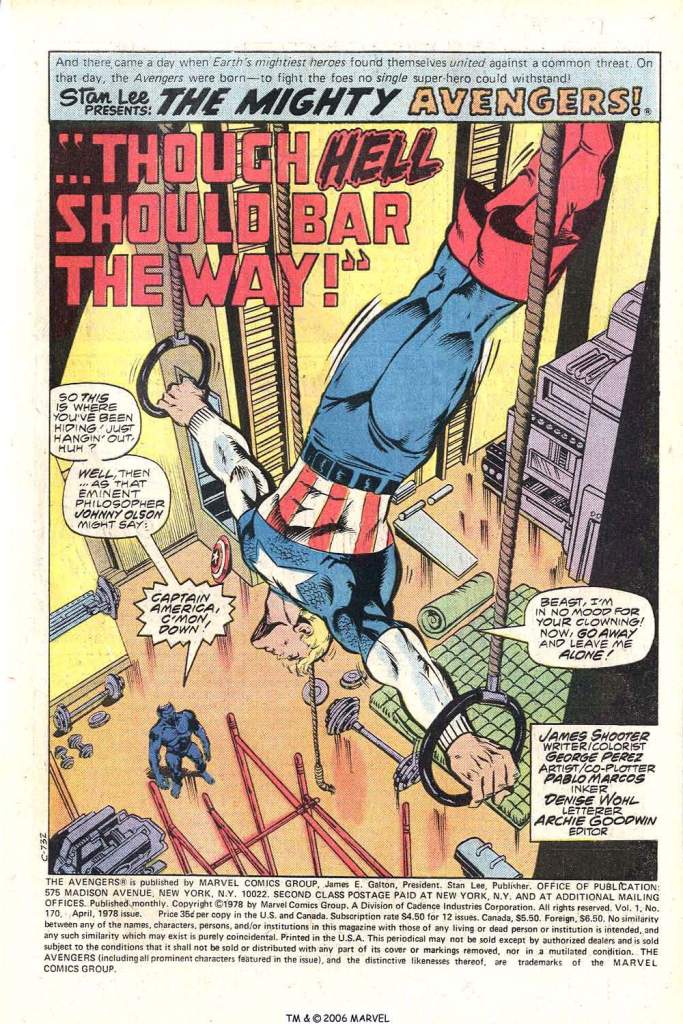
These two issues were much more focused than the one I had read before, and while the size of the team was still daunting, it wasn’t as daunting as when the Guardians of the Galaxy were also hanging around in the same space. As it turned out, even though it had been three months since I had last sampled AVENGERS, I hadn’t missed anything–the issue that came out in-between #168 and #170 had been a stand-alone fill-in story. Still, these two issues functioned as a self-contained two-parter within the larger context of the ongoing building subplot featuring Korvac. So I was more readily able to enjoy it a lot more.
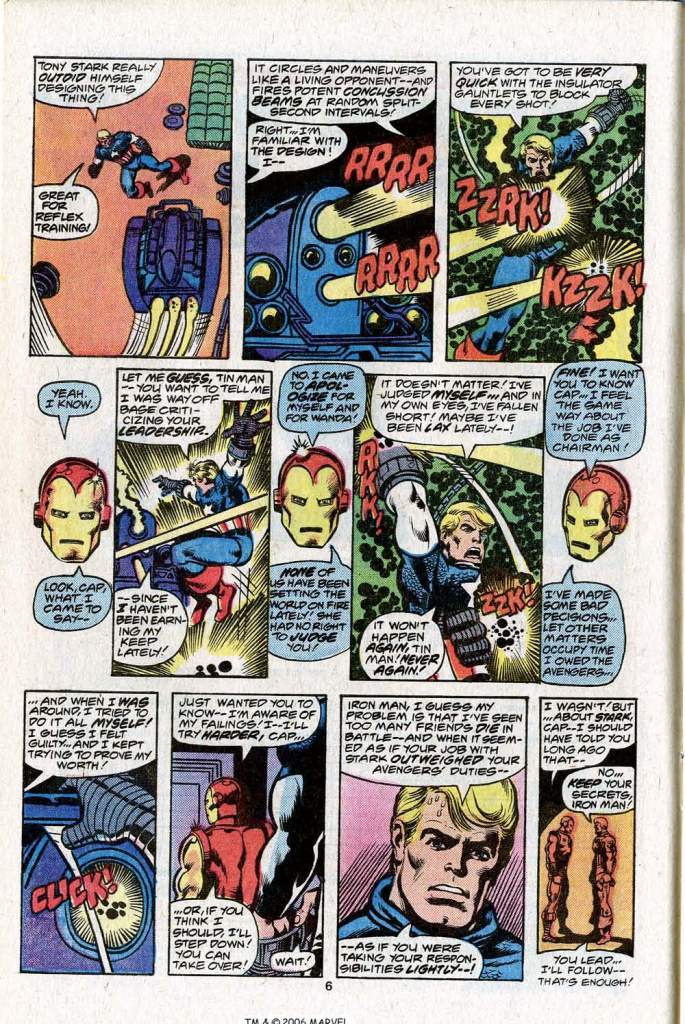
It’s also a comic book dense with incident. Just look at how many panels George Perez packs onto this page, and how many words writer Jim Shooter lays on top of them. The opening few pages resolves a situation that had been brewing in the title for a number of issues: Iron Man was then the Avengers chairman, and Captain America was having difficulties with his leadership style–so much so that he took a punch at Iron Man in the first issue I had read. (That punch, as much as anything, is the initial building block of what eventually became CIVIL WAR, as it cemented in my mind the notion that Captain America and Iron Man were characters whose ideological outlook was often in opposition to one another.) Here, though, the two men bury the hatchet, with a little bit of help from the Beast. The Beast was a great character in these days–fun, funny, witty. It’s a characterization that wound up shifting over time, becoming closer to his original studious bookworm X-Men persona. But this was teh Beast I liked best. And nobody ever drew this design better than Perez.

Shooter’s experiences writing the Legion of Super-Heroes served him in good stead here, as there are seemingly dozens of plotlines going on at once. The Scarlet Witch gets a frantic call from Hawkeye, who has been out west with the time-displaced Two-Gun Kid. But the Kid is missing, seemingly teleported away. Wanda assembles the Avengers to head off to investigate–and meanwhile, we cut to Attilan, where her brother Quicksilver lives with his wife, Crystal. Before Crystal’s eyes, Pietro vanishes as well, putting a pin on Hawkeye’s suspicions: there does seem to be somebody abducting Avengers. Back at Avengers Mansion, repair crews are rebuilding the section that was recently damaged by Count Nefaria, and are bringing the crate containing Jocasta, the would-be Bride of Ultron, back in for storage. But before the Scarlet Witch can tell the others about what’s going on with Hawkeye and about the Two-Gun Kid’s disappearance, Jocasta suddenly springs to life, bursting out of the crate that held her.
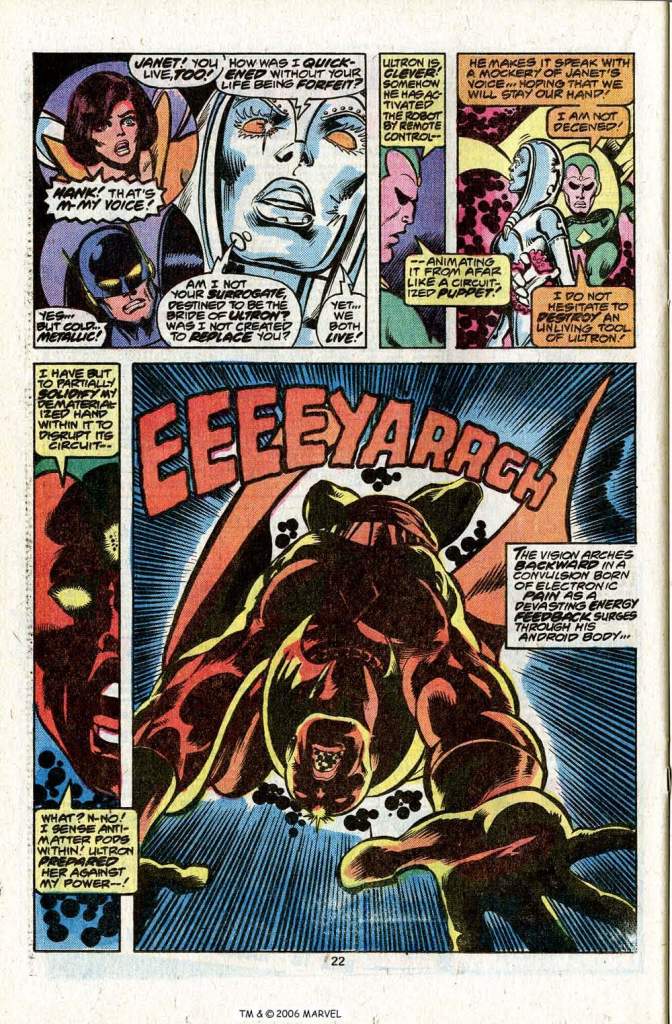
The reactivated Jocasta is confused about her sudden consciousness–even more so given that the Wasp is present, and it was Janet Van Dyne’s brain-engrams that were mean to be the basis for her life and personality. Nonetheless, she instinctively turns the repaired Avengers Mansion’s defenses back on the Avengers as she moves to make her escape from their custody. This turns into a running fight, one in which the Avengers are at least initially restrained by not wanting to knock the hell out of their just-repaired headquarters again. Perez is in fine form here, still jamming his pages with numerous panels but simultaneously keeping the action moving and giving the characters personality. Already, he was about my favorite artist at this time, and his skills were continuing to grow.

The fight progresses into the courtyard outside of the Mansion, where the Avengers feel a bit more free about unleashing the full scope of their powers. Unfortunately, Jocasta has been equipped by her creator Ultron with the means to defend herself–she’s powerful and dangerous. What’s more, Yellowjacket keeps urging the other Avengers not to destroy her if they can, as he wants to study her workings in depth. But eventually, as more and more Avengers are getting their heads handed to them, such restraint is no longer possible, and the team moves in for the kill–only to have their attack stymied by a last-minute arrival by Iron Man and Captain America, as the cover predicted.
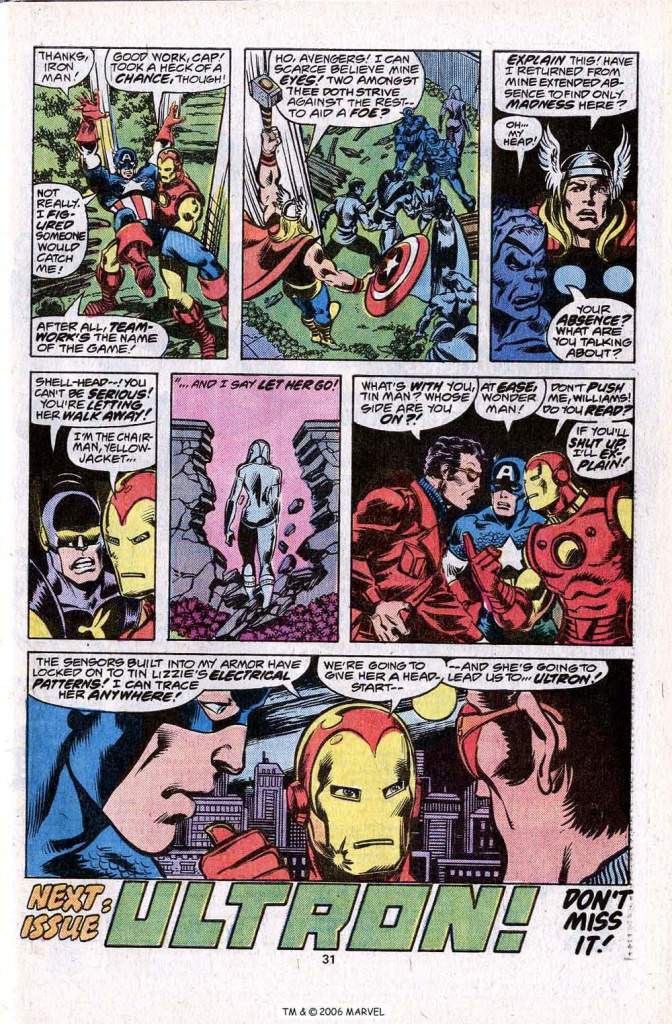
Once again, the Avengers are momentarily at one another’s throats, a recurring motif in Shooter’s run as writer it would seem. But cooler heads prevail with the unexpected arrival of Thor. He’d been showing up in recent issues unexpectedly to serve as a last minute reprieve for the team, so his appearance here is almost par for the course. And when everybody calms down, Iron Man tells him the plan: Jocasta has clearly been reactivated by Ultron, so if they give her a lead, he can track her with his armor, and she will lead them right to their foe. And that’s where this issue was To Be Continued! I moved immediately into the subsequent issue in my reading, but you’re going to have to wait a day for me to write about that one tomorrow.
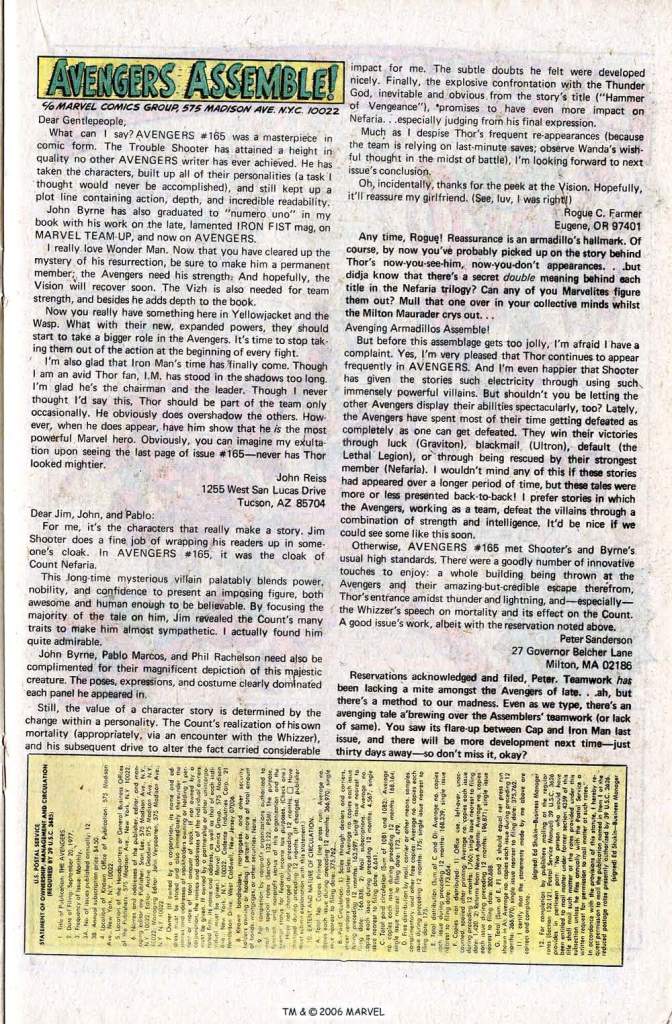
The letters page this time out included another correspondence from Peter Sanderson, who would go on to a career as a comics historian employed by both Marvel and DC, among others. Additionally, the Statement of Ownership for the year ran in this issue, which gives us some insight into how well AVENGERS was performing by 1978. It indicates that the book was selling 173,479 copies on a print run of 375,762, giving the book an Efficiency of 46%. That’s a pretty good number as compared to many of the other titles we’ve been looking at–an indicator that the Shooter and Perez team (along with John Byrne, who had drawn a string of recent issues as well) were moving the needle positively.

Ah, the thick of the Bronze Age! When almost every sentence ended in an exclamation point! Even unnecessarily! Like, “You should add salt to your pretzel!”
“No, thanks! My Dr. says I need to lower my sodium intake! But dont tell any one! I dont want them to think I’m a liability to the team!”
“OK, I won’t!”
“Thanks!”
“”No problem!”
Highly bombastic! And as the audience aged, it became annoying! I’m glad it started to change by the mid-80’s!
Cap’s only line in these posted page’s without an exclamation mark was “Not really.” But then ge immediately reverts back to the “!”.
That had to have been cool for you, Tom, to get George back on Marvel’s “A-Team” 20 years after he first helped solidify the book as a favorite of yours.
It’s cool to see George’s evolution, too, Some of that is his own doing, time limitations, and the impact of the inker. There are several panels that look like trademark Perez. But also others, like the close up, head shot of Cap unmasked, during his talk with Iron Man, where Goerge’s style is almost unrecognizable.
Compare that warmth what many fans regard as his peak period, 1983 to 1986, “New Teen Titans” & “Crisis on Infinite Earths”. Where his style seems more pristine & precise..
I say “peak”, but obviously he remained in great form for a long time after that.
LikeLiked by 1 person
The Perez run was definitely the gateway for me into following the Avengers religiously. I loved the way this issue opens with Cap working out. There were so many issues back in the day that opened this way, but it really did drive the point home at how hard Cap works, despite the fact that he has the Super Soldier Serum, to be at peak human condition. While others simply got their powers from accidents, coincidences, or by some grand design, Cap maintains his power through hard work and dedication. I always admired that about the character and it is the thing that keeps me going to the gym to this day (despite the diminishing returns due to my age). Great overview of a great issue!
LikeLike
Great observation, Mr. Miller. “My” Anengers was the Stern, J. Buscena, Palmer run in the mid-80’s, and there were scenes of Cap’s workouts then, too. And the Black Knight, for whom it made as much or more sense, since Dane had no physical enhancements at all.
Those scenes serve more than one purpose. I liked what you said about Cap’s hard work. I wonder if each person who contributed to the plots, whether editors, writers, or the artists, just knew to keep this in mind? To periodically show this, which shows a deep appreciation for the characters. Or if it was handed down, one of the tenants of writing the team. “Time for a workout scene”.
It helps define the characters for the readers. I remember seeing the Wasp testing her powers, like a physical check-up. And learning that at her diminutive size, she could bend steel. I had a little more respect for her after that. 🙂
LikeLike
A workout scene has the benefit that the characters can be doing something visually very interesting and dynamic, while having dialogue which advances the story. The discussion above between Cap and Iron Man would look extremely dull if it was just them standing around and talking. It’s the same reason some runs of X-Men would show so many Danger Room scenes.
Note intrinsically Cap will always be in peak human condition, that’s his superpower (and never getting tired in a fight is indeed a superpower, and actually extremely useful for a street-level/fighter type). He shouldn’t ever, e.g. need to lift weights or do resistance exercises. He has the physical base as given. What he strives for, is to maintain and enhance SKILL. The acrobatics and shield-throwing aren’t something that the Serum grants him. The depiction above is good because it shows how he trains for combat such as dealing with attacks and blocking them.
LikeLiked by 1 person
Writer/colorist is not a credit that one sees often. The only other example I can think of off the top of my head is Bob Rozaki on Hero Hotline.
LikeLiked by 1 person
*Rozakis
LikeLike
first person to comes to mind is Tom McCraw. When he did a store signing in the late 90s, he brought some of his color guides and I got a couple of the flash and Aquaman issues for just $10 a pop.
LikeLike